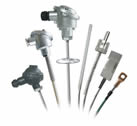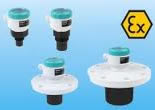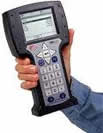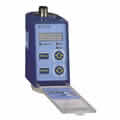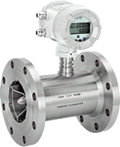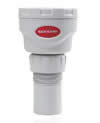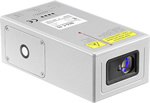Flow & Flowmeter
 A flowmeter is a device that measures the volume of material passing through time. In most industries, including oil and petrochemical industries, knowing the exact amount of fluid flow, such as gas or oil, is of particular importance due to technical and economic considerations. Note that the total flow, which represents the mass of the consumable material in many cases, such as industrial processes, economic application and is equivalent to the purchase or sale price of the material. Also, accurate flow measurement is of special importance due to financial considerations in the sale and purchase of a certain volume of material and goods, such as household gas meters and oil exchanges, etc.
A flowmeter is a device that measures the volume of material passing through time. In most industries, including oil and petrochemical industries, knowing the exact amount of fluid flow, such as gas or oil, is of particular importance due to technical and economic considerations. Note that the total flow, which represents the mass of the consumable material in many cases, such as industrial processes, economic application and is equivalent to the purchase or sale price of the material. Also, accurate flow measurement is of special importance due to financial considerations in the sale and purchase of a certain volume of material and goods, such as household gas meters and oil exchanges, etc.
There are several techniques used to measure flow, some of the most common of which are listed below.
Usually, these flowmeter samples move and measure a certain amount of fluid in the amount of raw or oval gears, and are mostly used for high viscosity materials such as oil.
Flowmeter with the help of Venturi
One of the oldest and most widely used methods of measuring the flow of different fluids is the sample of Orifis Plate. The simple structure of placing a plate with a hole calculated during the flow and measuring the pressure difference between the two sides of the plate is the possibility of measuring the fluid velocity and then the flow and flow rate is very simple and intelligent.
Turbine flowmeter can be used to measure the flow of different materials, but with low viscosity. This flow meter consists of a special turbine and counter that calculates the number of revolutions per minute of this turbine and is mostly used due to its reasonable price and simple mechanism. Also, compared to electromagnetic flowmeters, there is no need for fluid conduction in this instrument.
Variable surface flow meter or rotameter is almost the cheapest method of flowmetry of gaseous liquids and liquids and with the simple technique of ball or floating indicator in the fluid passing through a transparent tube, it is possible to read the flow rate.
Due to the low accuracy of this flowmeter, this sample is mostly used to see the flow visually and as a fluid flow indicator.
Metal tube models also benefit from the same mechanism, except that something like a valve is used with the ability to move in the passage of fluid. These flowmeters usually have a metal tube and a cube-shaped display and for sizes larger than two inches and in the form of Flange installations are used and are used for more features such as sending output to PLC or the possibility of measuring viscous fluid flow.
Ultrasonic flowmeter with Doppler phenomenon Ultrasonic: Doppler
Ultrasonic flowmeter with transfer time method and .... Ultrasonic: Transit Time, Time of Travel, Time of Flight
Ultrasonic or ultrasonic flowmeters are mostly used for dirty fluids such as sewage water and are widely used in portable samples for larger pipe sizes. These flowmeters use the Doppler process in physics and send ultrasonic waves to the moving fluid, and also return and frequency measurement have the ability to measure fluid velocity in a variety of models depending on the application and quality with different accuracy.
Magnetic electromagnetic flowmeter
Magnetic flowmeters are used in many cases for water and conductive materials due to their fluid conductivity and the penetration of electromagnetic waves due to their velocity. In different types of flowmeter, in the production of this flowmeter, the properties of the fluid and its application in the body material and its electrodes are considered. ...
Vertex flowmeters can be used to measure more fluids, even high-viscosity liquids such as oil and hot bitumen, and high-temperature fluids. The mechanism of this flowmeter model is based on a sensor that can measure the vibrations created by the eddy currents of the fluid after colliding with an obstacle in its path.
Weir and Flume Open channel flowmeter
To measure the high volume of flow in open canals and rivers by creating ducts with a specific shape and measuring the liquid level, the amount of water flow can be measured.
Corialis flowmeters are one of the most accurate and expensive examples of this instrument, which is able to measure more fluids with high accuracy. Most of these flowmeters are used in gas stations and oil industries where precision measurement is required in the precise process, as well as for items such as the sale and purchase of petroleum products.
thermal Mass flowmeter, due to the fact that in gaseous fluids, line pressure has a direct effect on measuring the amount of flow can be done with a mechanism that is independent of pressure and only by measuring the temperature of a temperature element with the help of a temperature sensor . Measure the desired flow rate.
To measure air ducts and more in HVAC or heating and cooling industries, Pitot tube models are used, which consist of an open bottom tube with a pressure gauge inside which the pressure inside is connected to the flow passing through the open end of the other side.

A: Suitable |
|||
To measure the flow of liquids |
|||
Ordinary liquids (such as water) |
A |
A |
A |
Very low flow rate (less than 2l / h) |
A |
A |
C |
Flow rate too high (more than 1,000,000 m3 / h) |
C |
A |
A |
Non-conductive liquids |
A |
C |
A |
High viscosity liquids (more than 50cp) |
A |
A |
B |
Refrigerant liquids (such as oxygen) |
A |
C |
B |
Sanitary applications |
A |
A |
A |
To measure the flow of gases and vapors
|
|||
Ordinary gases (like air) |
A |
C |
C |
Wet and dirty gases |
C |
C |
A |
Very low flow rate (less than 20 l / min) |
A |
C |
C |
Flow rate too high |
A |
C |
C |
Steam |
B |
C |
C |
Special applications
|
|||
Fluids with suspended solids, slurry |
B |
A |
C |
Liquid / liquid mixture (water / oil) |
A |
B |
B |
Liquid / gas mixture (water / air) |
B |
B |
C |
Corrosive liquids (acid, alcohol) |
A |
A |
A |
Corrosive gases (hydrochloride vapor) |
A |
C |
C |
Mine use (stone slurry) |
C |
A |
C |
Two-way measurement |
A |
A |
A |
Portable measurement without stopping the process |
C |
C |
A |
Tube size |
From 1 to 400mm |
From 2 to 2400mm |
From 15 to 4000mm |
Working pressure |
Maximum 400bar |
Maximum 40bar |
Depending on the sensor |
Working temperature (degrees Celsius) |
From 50 to 350 |
From 40 to 180 |
From 40 to 170 |
A: Suitable |
Differential pressure flowmeter / Orphis / Venturi |
||
To measure the flow of liquids
|
|||
Ordinary liquids (such as water) |
A |
B |
A |
| Very low flow rate (less than 2l / h) |
C |
C |
C |
| Flow rate too high (more than 1,000,000 m3 / h) |
C |
C |
A |
| Non-conductive liquids |
A |
B |
A |
| High viscosity liquids (more than 50cp) |
B |
B |
B |
| Refrigerant liquids (such as oxygen) |
A |
C |
A |
| Sanitary applications |
C |
B |
C |
To measure the flow of gases and vapors |
|||
| Ordinary gases (like air) |
A |
A |
A |
| Wet and dirty gases |
B |
B |
C |
| Very low flow rate (less than 20 l / min) |
C |
A |
B |
| Flow rate too high |
A |
A |
A |
| Steam |
A |
C |
A |
Special applications
|
|||
| Fluids with suspended solids, slurry |
B |
C |
B |
| Liquid / liquid mixture (water / oil) |
A |
B |
B |
| Liquid / gas mixture (water / air) |
B |
B |
B |
| Corrosive liquids (acid, alcohol) |
A |
C |
A |
| Corrosive gases (hydrochloride vapor) |
B |
B |
A |
| Mine use (stone slurry) |
C |
C |
C |
| Two-way measurement |
C |
C |
A |
| Portable measurement without stopping the process |
C |
C |
C |
| Tube size |
From 1 to 400mm |
From 2 to 2400mm |
From 15 to 4000mm |
| Working pressure |
Maximum 400bar |
Maximum 40bar |
Depending on the sensor |
| Working temperature (degrees Celsius) |
From 50 to 350 |
From 40 to 180 |
From 40 to 170 |
- Popular products

German laser thermometer with external thermocouple K tool 1725

Level controller / roller blade switch for solids and powders, model 1872

Industrial Laser Thermometer Instrument 1727

12-channel temperature recorder thermocouple tool 1189


